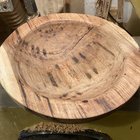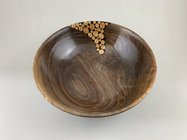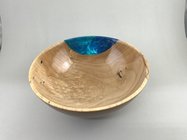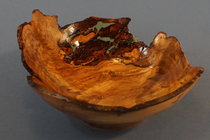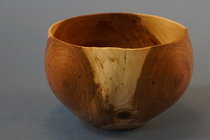Roberto -- You've heard from the 'life's too short to turn crappy wood camp'. But, while generally, that may be true, there can be times when even a long-time camp member might wish to turn such a blank. For example, the wood might have significant sentimental value. Or, you just think the resulting bowl will look way cool with its radiating rays of contrasting colors. Whatever the reason, you've said that you'd like to turn these cracked blanks. If I had a similar blank and were determined to salvage it, I would take one of two approaches -- depending mostly on the size of the blank.
Method 1: I would first stabilize the blank using cactus juice. My reason for doing this would be to limit the amount of wood movement in the future. Assuming good penetration, a stabilized blank acts more like a resin blank than a wood blank when it comes to wood movement. After the blank has been stabilized, I would cast the blank in epoxy (or, more likely, Alumilite Clear Slow, which is a urethane resin, not an epoxy). To cast the blank, I would turn a waste block to fill up most of the interior of the bowl. The purpose of the waste block is not just to take up space, to reduce the use of expensive resin. The purpose is also to reduce the depth of the pour, helping the resin to cure without getting too hot. Done properly, this would produce a sound blank that would be safe to turn.
This is my preferred method. However, it can't be used if the blank won't fit in the vacuum chamber or the oven used for stabilizing. And, of course, it can't be used if the blank won't fit in the pressure pot. (A pressure pot isn't required for casting if a slow curing epoxy resin is used. Some epoxy casting resins might have an open time measured in hours, which allows plenty of time for air bubbles to rise to the surface. As I said, I generally use Alumilite Clear Slow, which has an open time of about 12 minutes. In such a case, a pressure pot is used to compress any air bubbles in the resin to a size that cannot be seen by the human eye.)
Method 2: If the blank won't fit in my toaster oven (which is smaller than my vacuum chamber and my pressure pot), I would use a high-quality packing tape to seal the outside of any cracks and then fill the cracks with slow curing casting epoxy. I would make sure the resin is designed for 'deep pours'. Properly done, this should result in a sound blank that can be safely turned. However, the wood and epoxy will move at different rates in response to changes in humidity and temperature. Over time, I would expect wood and epoxy will separate. That is, I expect that a small hair-line crack will develop along the edges of where the epoxy and wood meet. I also expect it would take years for that to happen.
HTH
David

![20221001_130711[1].jpg](/community/data/attachments/44/44280-3574a5fb415d5bf2e5ef5120b78b0b81.jpg?hash=NXSl-0FdW_)

